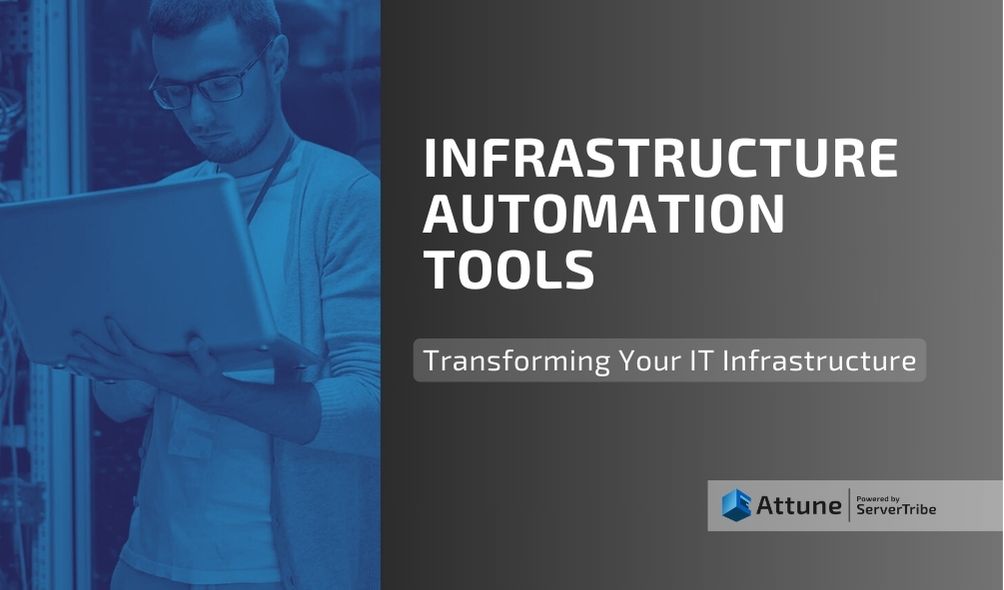Top Infrastructure Automation Tools: Transforming Your IT Infrastructure
Written by
Shivam Mahajan on the 23rd Jan 2024
In today’s chaotic digital world, where businesses rely on technology to perform smarter than ever before, there’s a lot of hype about making infrastructure administration incredibly seamless and automated. Think about solutions that can act like magic to assist firms in managing, expanding, and fine-tuning their technology settings with extraordinary speed and precision.
This post is all about digging into the world of such excellent Infrastructure automation tools, discovering why they’re awesome, who the main players are, and how they’re completely changing the game for how things work nowadays.
Development of Infrastructure Automation
The days when IT staff used to manually manage and configure servers, networks, and other infrastructure parts are a thing of the past. The requirement for quickness, reliability, and scalability has led to the development of infrastructure automation solutions as organisations battle with the need to offer applications and services quickly. These solutions enable businesses to specify their infrastructure as code, decreasing the need for manual intervention and human mistakes.
The Positive Effects of Infrastructure Automation Tools
- Efficiency and Speed: Automation reduces the need for labour-intensive, repetitive manual procedures. Provisioning and configuring resources, scaling applications, and managing upgrades become more efficient and quicker, leading to shorter delivery cycles.
- Consistency: Because infrastructure is described as code, configurations are standardised and consistent across environments. This consistency reduces configuration drift and ensures that production settings are identical to those in testing and development environments.
- Flexibility: Infrastructure automation solutions allow firms to easily scale up or down resources based on demand. This flexibility is essential for dealing with spikes in traffic or supporting growing user bases.
- Reduced Errors: Manually configuring infrastructure exposes users to human mistakes. Misconfigurations are reduced via automation, which improves system dependability and security.
- Cost reductions: By optimising resource consumption and reducing human work, infrastructure automation can result in significant long-term cost reductions.
What Operations in the IT Infrastructure Can Be Automated Using the Tools?
Are you wondering what operations in the IT Infrastructure can be automated using automation tools?
Well, to make you understand, below are the top operations where you can use automation tools to make your IT infrastructure work easier.
Infrastructure automation technologies help clusters in an IT infrastructure independently manage and support their activities. It allows for cluster downtime while increasing user availability.
Infrastructure automation technologies aid in the transformation of data centers into private or hybrid cloud environments. It grows the data center in line with its provider and the organisation’s goals.
Another activity that is automated with infrastructure automation technologies is network automation. It allows quicker application deployment, full application life-cycle automation, and security service networking.
- DevOps for Infrastructure
DevOps may use infrastructure automation technologies to act as software on physical infrastructure. Instead of manual procedures, it supports, orchestrates, and automates Infrastructure as Code (IaC).
Top Infrastructure Automation Tools
Several tools are present in the world of infrastructure automation, each with its own unique set of capabilities and features. Below are some of the best tools that are present in the automation world. Check them out right away.
Terraform
HashiCorp’s Terraform, an innovative infrastructure automation tool, alters resource provisioning. It is written in code and allows users to develop, change, and manage infrastructure using declarative settings.
Terraform guarantees consistency across environments by supporting a variety of cloud providers and services. Its infrastructure-as-code approach simplifies deployment, scalability, and administration.
Key Features and Benefits
- The declarative configuration ensures that infrastructure is put up consistently.
- Support for several clouds for large provider compatibility.
- Approach to infrastructure as code (IaC) for efficient management.
- You can achieve scalability and agility through automated provisioning.
- Reduced mistakes and increased deployment reliability.
Ansible
Ansible, a powerful open-source automation tool, changes IT operations. The platform allows configuration management, application deployment, and job automation across multiple systems, focusing on simplicity and agentless design. It enables IT teams to design infrastructure as code and smoothly automate complicated operations using human-readable YAML syntax.
Ansible transforms IT processes by reducing activities, increasing productivity, and increasing scalability, making it a key component of current automation strategies.
Key Features and Benefits
- Automation without agents for more efficient configuration management
- For simple infrastructure as code, use human-readable YAML syntax.
- Idempotent operations ensure that system states are consistent.
- An approach based on a playbook that promotes cooperation and repeatability.
- Versatility in a variety of systems and applications.
Attune
Attune is a cutting-edge digital systems automation and orchestration solution designed to elevate your operational efficiency to new heights. Attune seamlessly automates and orchestrates scripts, commands, and processes, replicating the precision of manual entries performed by skilled system administrators.
Embracing a non-intrusive approach, Attune establishes connections with operating systems through WinRM and SSH protocols, eliminating the need for agent installations. Crafted using widely adopted shell scripting languages, Attune empowers your organisation with unparalleled flexibility and familiarity.
Unlock a realm of possibilities with Attune’s automation prowess:
Simple SysOps Automation Tool
AttuneOps is the fast, light, and easy way for System Admins to orchestrate scripts. Stop manually running your scripts through the terminal.
Chef
Chef, a popular configuration management and automation tool, is changing the face of IT infrastructure. Chef automates system setup, deployment, and administration using domain-specific language, maintaining consistency across complicated contexts.
Chef’s real-time monitoring and reporting provide more insight into system status. The platform enables enterprises to achieve operational excellence and speed their development by simplifying maintenance and avoiding downtime.
Key Features and Benefits
- Configuration management and automation using a domain-specific language
- Infrastructure as code for efficient provisioning and scalability
- A recipe-driven method for consistent setups and fewer mistakes.
- Real-time monitoring and reporting for improved system visibility
- The client-server architecture easily propagates configuration changes.
Puppet
Puppet, an innovative configuration management tool, is reshaping IT operations. Puppet automates infrastructure orchestration and administration by using a model-driven approach. It enables consistency across multiple platforms by specifying settings as code.
Puppet automates activities, minimises manual mistakes, and shortens software delivery cycles, making it a must-have solution for modern organisations seeking scalability, dependability, and efficiency in their IT workflows.
Key Features and Benefits
- Model-driven infrastructure management automation.
- Declarative language guarantees that system states are consistent.
- Client-server architecture for configuration dissemination that is smooth.
- Monitoring and reporting in real-time improve visibility.
- Operations are streamlined, and human mistakes are minimised.
Summing Up
Automation will almost certainly play a more significant role in infrastructure management as technology advances. Businesses that effectively integrate and utilise the potential of automation will be better positioned to face the challenges of the digital world and provide their consumers with excellent goods and services.
Infrastructure Automation Tools: Frequently Asked Questions
How do you manage infrastructure automation?
Managing infrastructure automation involves utilising several kinds of technological methods and tools:
Use technologies like Terraform or Ansible to codify and provide infrastructure, describing the desired state programmatically.
- Configuration Management:
To systematically enforce and manage consistent settings across servers, use technologies such as Puppet, Chef, or Ansible.
Use orchestration solutions such as Kubernetes or Docker Swarm to automate containerised application deployment, scaling, and administration.
- Continuous integration and deployment (CI/CD):
Create CI/CD pipelines using solutions like Jenkins or GitLab CI to automate testing and deployment procedures, assuring fast and reliable code updates.
Implement monitoring technologies such as Prometheus and logging solutions such as ELK Stack to track infrastructure health, identify problems, and assist in fast troubleshooting.
To track changes in infrastructure code, use version control systems like as Git, which allow for traceability, collaboration, and version management.
What are the different approaches to infrastructure automation?
Infrastructure automation is the process of managing and provisioning server infrastructure via the use of tools and procedures. There are several ways to accomplish this:
Creating scripts in languages such as Bash, PowerShell, or Python to automate monotonous activities. These Scripts can run instructions and configure infrastructure components by following a set of specified processes.
- Configuration Management:
Using tools such as Ansible, Puppet, or Chef to specify and enforce the intended state of the infrastructure. Such tools employ declarative language to define configuration, guaranteeing that systems remain in the stated condition.
Infrastructure is defined and managed using code, such as Terraform or CloudFormation. This enables you to codify infrastructure needs, making it easier to version control, share, and replicate setups.
Applications and their dependencies are packaged inside containers (such as Docker) for consistent deployment across several environments. These containers are a lightweight and portable solution to ensure that programs execute reliably across several environments.
Coordinating and controlling many automated tasks and services such that they function together effortlessly. Tools like Kubernetes and Docker Swarm assist in coordinating containers, ensuring that applications are deployed, scaled, and managed efficiently.
What is infrastructure as a code tool?
An Infrastructure as Code (IaC) tool is a software solution that programmatically defines and manages IT infrastructure resources using machine-readable script or configuration files. IaC technologies automate infrastructure provisioning, setup, and administration, resulting in consistent, repeatable, and scalable deployments across a variety of scenarios.
These tools work on a declarative or imperative basis, with the user specifying the intended state of the infrastructure and the tool implementing and maintaining that state. Declarative IaC tools, such as Terraform, employ configuration files to specify the intended infrastructure state, whereas imperative solutions, such as AWS CloudFormation, use scripts that provide step-by-step instructions to accomplish the required configuration.
The idea is to approach infrastructure as code, incorporating software development principles into infrastructure management to increase efficiency, dependability, and scalability in modern IT operations.
What is infrastructure provisioning automation?
Infrastructure provisioning automation is the process of setting up the desired state of the infrastructure using tools, scripts, or configuration files. This may involve describing the number of servers, networking setups, operating system settings, and program installs. The objective is to guarantee that infrastructure is provided consistently and effectively, whether in on-premises or cloud settings.
Key elements of infrastructure provisioning automation include:
- Templates or scripts: Using preset templates, scripts, or configuration files to explain the infrastructure’s configuration and provisioning processes.
- Cloud APIs and Services: Using cloud providers’ APIs or services to dynamically distribute and configure resources depending on predefined criteria.
- Orchestration: Coordinating the provisioning process by controlling task order and dependencies, resulting in a seamless and logical deployment sequence.
- Scalability: The capacity to dynamically scale infrastructure resources in response to demand, allowing for more effective use of computer resources.
Post Written by Shivam Mahajan
Shivam Mahajan is an editor skilled in SysOps, Tech, and Cloud. With experience at AttuneOps and other companies, he simplifies complex technical material for easy understanding.



Comments